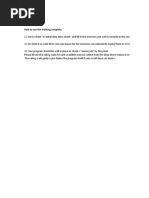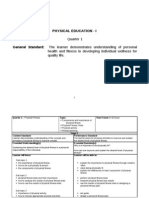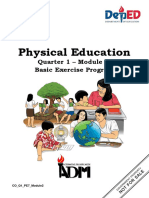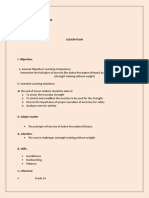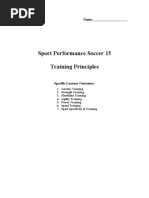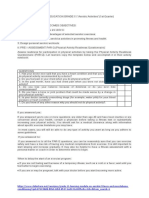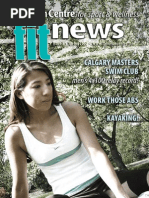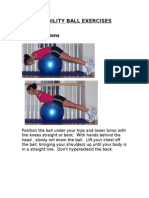Objectives and Assessment
Objectives and Assessment
Uploaded by
api-325943973Copyright:
Available Formats
Objectives and Assessment
Objectives and Assessment
Uploaded by
api-325943973Original Title
Copyright
Available Formats
Share this document
Did you find this document useful?
Is this content inappropriate?
Copyright:
Available Formats
Objectives and Assessment
Objectives and Assessment
Uploaded by
api-325943973Copyright:
Available Formats
Objectives & Assessments
Weight Lifting
Objectives
I.
Setting a Wight lifting
Goal
Terminal
I.1 From your research, discuss
the lifter(s) weight lifting goal. Use
2-3 facts to explain why this goal
fits your lifter(s) needs.
Assessments
I.1 Question Type: Essay
Sample Question: What is the desired outcome for your
weight lifting group? Explain the goal that you have chosen.
I.1.1 Question type: Short Answer
Sample Question: Based on your research, what goal do
you feel will benefit your group? Why does that goal fit your
lifting group?
Enabling
I.1.1 Learner will research and
select a tone or athletic regimen
I.1.1.a Athletic Lift contains
high weight & Low reps
I.1.1.b Tone regimen contains
low weight & high reps
II.
Designing a Weight lifting
II.1 Question Type: Product Development
regimen
Terminal
II.1. In groups, construct the
proper warm-up sequence. Give 2
reasons why this warm-up
sequence benefits your lifter(s).
Sample Question: Design a warm-up chart for your lifter(s)
to follow before starting and after your lift. Chart should
contain: Number of reps/distance/count
Grading rubric:
Yes
No
Stretches are
designated on
chart
Chart contains
number of
reps/distance/coun
t
Enabling
II.1.1. Research and identify the
difference between a Dynamic
and Static warm-up
II.1.1.a Learner will determine
II.1.1. Question Type: Short Answer
the components of a Dynamic
Sample Question: What are the component of a
warm-up using research
Dynamic and Static warm-up?
II.1.1.b Learner will determine
the components of a Static Warmup using research
II.1.2 Question Type: Multiple Choice
Enabling
II.1.2 Using research the learner
will select a warm-up that will
benefit their lifter(s).
Sample Question: A baseball players is completing a
series high knees and walking arm circles as a warm-up.
Which form of stretching is the baseball player completing?
A. Static Warm-up
B. Dynamic Warm-up
Objectives & Assessments
Weight Lifting
Question Type: Short Answer
Sample Question: A cross country runner is sitting on the
floor to completing a hamstring stretch. What type of warm-up
is the runner performing?
II.
Designing a Weight lifting
II.2 Question Type: Product Development
regimen
Terminal
II.2. From your research,
construct a regimen of lifts to
meet the lifter(s) goal. Using 2-3
sentences to explain why you
selected these lifts for your
program.
Enabling
II.2.1 The learner will research
and Identify what upper body lifts
will meet the lifter(s) goal.
II.2.1.a Upper body lifts
consist of bench press, pull
downs, curls, etc.
II.2.2. The learner will research
and Identify what lower body lifts
will meet the lifter(s) goal.
II.2.2.a Lower body lifts
consists of squats, leg curls,
deadlift, etc.
II.2.3 The learner will research
and identify what core lifts will
meet the lifter(s) goal.
II.2.3.a Core lifts consists of
abs circuit, back extension,
planks, etc.
II.
Terminal
Sample Question: From your research, develop an upper
body, lower body, and core lifting regimen for your lifters goal.
Must contain the lift and the number of repetitions per lift
Lifting regimen
contains:
Upper body lifts
Lower body lifts
Core lifts
Number of reps
Yes
No
II.2.1 Question Type: Short Answer
Sample Question: Following your research, what
upper body lifts would you deem are important for a person
looking to tone their muscles for sprinting events?
II.2.2. Question Type: Short Answer
Sample Question: Using your research as a guide,
which lower body lifts would assist a softball pitcher for
increasing the strength of her legs for pitching?
II.2.3 Question Type: Short Answer
Sample Question: From your research, what core lift
would benefit an offensive lineman to maintain proper position
for pass blocking?
Designing a Weight lifting
II.3 Question Type: Short Answer
regimen
Sample Question: Based on your research, explain the
Objectives & Assessments
Weight Lifting
II.3 Using research, discuss the
goal for applying finishers in a
lifting regimen. Use 3 reasons
why these finishers would allow
your lifter to burn out the targeted
muscle group.
Enabling
II.3.1. The learner will research
and identify the proper finishers
for an upper body lift.
II.3.1.a Upper body finishers
need to burn the remainder of the
muscle, lifts consists of rhythmic
ropes, medicine ball throw, etc.
II.3.2. The learner will research
and identify the proper finishers
for a lower body lift.
II.3.2.b Lower body finishers
need to burn the remainder of the
muscle, lifts consists of sprints,
box jumps, dot drills, etc.
II.
Designing a Weight lifting
regimen
Terminal
II.5 Using research, discuss the
proper recovery based on the
lifter(s) goal. Provide 3 reasons for
your rationale of recovery
supplements.
Enabling
II.5.1 The learner will define the
appropriate supplement regimen
for the recovery of the lifter(s)
II.5.1.a Recovery
supplements consists of vitamins
and/or Protein shakes
V.
Lifting Tests
Terminal
purpose for using finishers in a lifting regimen. What does it do
to the weight lifter?
II.3.1 II.3.2 Question Type: Matching
Sample Question: Identify the upper and lower
body finishers in the list provided. Mark U upper body and L
lower body
Rhythmic ropes _______
________
Dot Drill _______
Four cone Drill ________
Medicine ball throw
Planks _______
Wall sits _______
II.5 Question Type: Essay
Sample Question: From your research of articles from
doctors and strength & conditioning coaches, explain your
position on recovery supplements. Should students be
allowed to use supplements? What supplements, if any, should
lifters incorporate at the end of the lift?
II.5.1 Question Type: Short Answer
Sample Question: What is the purpose for these
recovery supplements, such as protein shakes, vitamin packs,
and creatine?
V.1 Question Type: Product Development
Sample Question: Design a chart of lifts to assess the
Objectives & Assessments
Weight Lifting
V.1 Using research, develop a
chart of lifts that will evaluate the
lifter(s) goal. State 2 3 reasons
for selecting your test lifts.
-Enabling
V.1.1 The learner will identify the
lifts that would assess the gains of
the lifter(s),
V.1.1.a test should contain
the primary lifts, such as (bench
press, squat, deadlift, etc.)
lifters to determine if the goal was met. Chart should contain
Upper Body and Lower Body lifts.
Chart contains:
Yes
No
Basic Upper Body
Lifts
(i.e., bench, pull
ups, etc.)
Basic Lower Body
Lifts
(i.e., Squat,
deadlift, etc.)
V.1.1 Question Type: Short Answer
Sample Question: What type of lifts should a designer
use to assess the lifters goal? How many reps should these
contain? Explain
You might also like
- RP Male Physique Template 3x Week Full BodyDocument3 pagesRP Male Physique Template 3x Week Full BodyXue Adams50% (22)
- Personal Trainer Case StudyDocument49 pagesPersonal Trainer Case StudyOana Popa60% (10)
- Build Your ArmsDocument18 pagesBuild Your ArmsMathieuNo ratings yet
- Pullup Progression Template For CrossFitDocument4 pagesPullup Progression Template For CrossFitAubrey De WetNo ratings yet
- StrengthProgram x4Document10 pagesStrengthProgram x4deNo ratings yet
- Lesson Plan Pe 6Document39 pagesLesson Plan Pe 6Ray Belardo100% (5)
- Bill Starr - Enhancing Endurance 1 - 2Document12 pagesBill Starr - Enhancing Endurance 1 - 2TomSusNo ratings yet
- Rip Training: 1.) Rip Paddle Board RowDocument1 pageRip Training: 1.) Rip Paddle Board RowryanjfowlerNo ratings yet
- Cube Kingpin MethodDocument9 pagesCube Kingpin MethodDaniel KocmielNo ratings yet
- TMSTR Tihanyi Development of Explosive Strength According To MusclDocument7 pagesTMSTR Tihanyi Development of Explosive Strength According To Musclmarin0410No ratings yet
- Final Project Tech EdDocument20 pagesFinal Project Tech Edapi-224390226No ratings yet
- Class 11 Annual Examination Answer KeyDocument11 pagesClass 11 Annual Examination Answer Keyaaryanbansal102No ratings yet
- Class Xi Subject - Docx CH 6Document1 pageClass Xi Subject - Docx CH 6mr.sparsh2008No ratings yet
- NCDC-S1 and S2 PHYSICAL EDUCATION SAMPLE ASSESSMENT ITEMS 2022Document12 pagesNCDC-S1 and S2 PHYSICAL EDUCATION SAMPLE ASSESSMENT ITEMS 2022ayikoyoroy10No ratings yet
- Exercise Instructor Manual Written TestDocument5 pagesExercise Instructor Manual Written Testbodycoach2No ratings yet
- Formative Assessment QuestionsDocument2 pagesFormative Assessment Questionsapi-325943973No ratings yet
- Problem IdentificationDocument10 pagesProblem Identificationapi-224390226No ratings yet
- Toddle d70cb038 67bb 4859 8648 56b4dfc2d300 Criterion A and D Summative AthleticsDocument9 pagesToddle d70cb038 67bb 4859 8648 56b4dfc2d300 Criterion A and D Summative AthleticsdefnesermenNo ratings yet
- Module 4 Assignment: Assignment 4.1: The Impact of Sporting BehaviourDocument2 pagesModule 4 Assignment: Assignment 4.1: The Impact of Sporting BehaviourTsiswdymmmaaNo ratings yet
- Yr 7 Lesson1 Agility WupsDocument2 pagesYr 7 Lesson1 Agility Wupsapi-307545096No ratings yet
- Biomechanics - in - Sport Projectile MotionDocument26 pagesBiomechanics - in - Sport Projectile MotionZi Liang WoonNo ratings yet
- MAPEH 12 Q4-WK1-2 SelfAssessesHealth-RelatedFitness (HRF) &SetsFrequencyIntensityTimeType (FITT)Document6 pagesMAPEH 12 Q4-WK1-2 SelfAssessesHealth-RelatedFitness (HRF) &SetsFrequencyIntensityTimeType (FITT)Emarkzkie Mosra Orecreb100% (1)
- PRY 2 PHE First Term EnoteDocument14 pagesPRY 2 PHE First Term EnoteOsunde RaymondNo ratings yet
- K12 Grade 7 Physical Education FIRST QUARTER TEACHING GUIDEDocument19 pagesK12 Grade 7 Physical Education FIRST QUARTER TEACHING GUIDEDepEdResources96% (52)
- Primer On Program DesignDocument9 pagesPrimer On Program DesignKat RickerNo ratings yet
- Lesson 1 PeDocument7 pagesLesson 1 PeglazegamoloNo ratings yet
- Download Training and Conditioning Young Athletes 2nd Edition Udor B. Bompa Ph.D & Sorin O. Sarandan Ph.D ebook All Chapters PDFDocument81 pagesDownload Training and Conditioning Young Athletes 2nd Edition Udor B. Bompa Ph.D & Sorin O. Sarandan Ph.D ebook All Chapters PDFlouilarrasv7100% (2)
- Course Guide Pe1 PDFDocument4 pagesCourse Guide Pe1 PDFrahskkNo ratings yet
- Module Teaching Pe in Elementary GradesDocument102 pagesModule Teaching Pe in Elementary GradesIvon Quirante CabalesNo ratings yet
- Phyical EduDocument4 pagesPhyical Edupriyanshumandal93No ratings yet
- Ist 626 Mid Term BynumDocument7 pagesIst 626 Mid Term Bynumapi-273840516No ratings yet
- FR Training Cert Worksheets 080412 2Document8 pagesFR Training Cert Worksheets 080412 2api-30886506No ratings yet
- Critical AnalysisDocument16 pagesCritical Analysisapi-391604222No ratings yet
- Bishop Study Guide 1Document8 pagesBishop Study Guide 1Faisal Mohad Al SakhenNo ratings yet
- Pe7 q1 Mod2 Basic-Exercise-ProgramDocument22 pagesPe7 q1 Mod2 Basic-Exercise-ProgramMark Christian PatricioNo ratings yet
- Pe7 q1 Mod2 Basic-Exercise-ProgramDocument22 pagesPe7 q1 Mod2 Basic-Exercise-ProgramIan Vencent JamillaNo ratings yet
- 11th PHYSICAL EDUCATION CBSE QUESTION BANKDocument3 pages11th PHYSICAL EDUCATION CBSE QUESTION BANKpradeep87810No ratings yet
- PE LESSON 1Document3 pagesPE LESSON 1Wilfrex TalabonNo ratings yet
- Digital Unit PlanDocument5 pagesDigital Unit Planapi-376809503No ratings yet
- Module4WellnessPlan 4.06Document10 pagesModule4WellnessPlan 4.06GeovanaNo ratings yet
- Physical Fitness Test Score CardDocument3 pagesPhysical Fitness Test Score CardElle ィ ۦۦNo ratings yet
- ПрезентацияDocument9 pagesПрезентацияфафа фафаNo ratings yet
- Full Download Training and Conditioning Young Athletes 2nd Edition Udor B. Bompa PH.D & Sorin O. Sarandan PH.D PDFDocument84 pagesFull Download Training and Conditioning Young Athletes 2nd Edition Udor B. Bompa PH.D & Sorin O. Sarandan PH.D PDFziemagnet100% (1)
- Activity-for-Physical-Education-and-HealthDocument14 pagesActivity-for-Physical-Education-and-HealthrainrainpoliquitNo ratings yet
- Lesson Plan (2)Document3 pagesLesson Plan (2)Jordan OfianaNo ratings yet
- GRADE 7 P.E Q1 M1&2 Wk4Document8 pagesGRADE 7 P.E Q1 M1&2 Wk4Elma AlbertoNo ratings yet
- ESS Practice Developmental Log - (2022 WA 1)Document6 pagesESS Practice Developmental Log - (2022 WA 1)Lavinne WongNo ratings yet
- Ava Jump Mat Lab 351Document4 pagesAva Jump Mat Lab 351marnieNo ratings yet
- Ped 026 Sas Lesson 3Document57 pagesPed 026 Sas Lesson 3Glenn PlecisNo ratings yet
- Lesson PlanDocument5 pagesLesson PlanChris PresentacionNo ratings yet
- Physical Education 8 (Quarter 2.1) - Learning Material PDFDocument40 pagesPhysical Education 8 (Quarter 2.1) - Learning Material PDFMaryGleeAnneSalazar100% (3)
- Detailed Lesson Health 8Document4 pagesDetailed Lesson Health 8Recelmy RaloNo ratings yet
- Module Two Wellness PlanDocument8 pagesModule Two Wellness PlanAshley AmbroseNo ratings yet
- Biomechanics Jigsaw ActivityDocument1 pageBiomechanics Jigsaw Activityapi-277667011No ratings yet
- Yr10 Ex Phys Research Assessment '24Document4 pagesYr10 Ex Phys Research Assessment '24avakennedydaviesNo ratings yet
- Training Principles ModuleDocument18 pagesTraining Principles ModuleEzzy Samuel DicksonNo ratings yet
- Exercise 2.4 Career Decision and Goals FA24Document2 pagesExercise 2.4 Career Decision and Goals FA24g0biipers0nNo ratings yet
- Q4 HOPE 2 - Module 5Document10 pagesQ4 HOPE 2 - Module 5May Ann GodezanoNo ratings yet
- Client Training Plan Level 1Document2 pagesClient Training Plan Level 1api-242256654No ratings yet
- Developing Mcqs For RCPSCDocument18 pagesDeveloping Mcqs For RCPSCnamavaya100% (1)
- Mapeh 7 Unit TestDocument4 pagesMapeh 7 Unit TestMaria DayhenNo ratings yet
- BPE Quiz SampleDocument12 pagesBPE Quiz SampleKhaironesa P. PahmNo ratings yet
- Outline Example TemplateDocument2 pagesOutline Example TemplateamanuelNo ratings yet
- Lesson PlanDocument6 pagesLesson PlanShaleemar Joy NavalNo ratings yet
- Aerobics ActivitiesDocument21 pagesAerobics ActivitiesEdwardJohnG.CalubIINo ratings yet
- Module 3 ADMINISTRATION SCORING AND INTERPRETATION OF SELECTED TESTSDocument9 pagesModule 3 ADMINISTRATION SCORING AND INTERPRETATION OF SELECTED TESTSralphlaroza7No ratings yet
- Technology Coordinator PaperDocument6 pagesTechnology Coordinator Paperapi-325943973No ratings yet
- Tech Talk PaperDocument6 pagesTech Talk Paperapi-325943973No ratings yet
- Digital DivideDocument2 pagesDigital Divideapi-325943973No ratings yet
- Privacy and SecurityDocument3 pagesPrivacy and Securityapi-325943973No ratings yet
- Culmination PaperDocument28 pagesCulmination Paperapi-325943973No ratings yet
- Mail Merge For Final PortfolioDocument2 pagesMail Merge For Final Portfolioapi-325943973No ratings yet
- Vertical Jump and PowerDocument10 pagesVertical Jump and PowerPablocJesusNo ratings yet
- CrossFit Skills ChartDocument5 pagesCrossFit Skills ChartTamas HeviziNo ratings yet
- Spine in Sports PDFDocument223 pagesSpine in Sports PDFceceetvero100% (5)
- Hybrid Plan 2.0 GlenDocument4 pagesHybrid Plan 2.0 Glenniels.kingetNo ratings yet
- Complexity: A Novel Load Progression Strategy in Strength TrainingDocument5 pagesComplexity: A Novel Load Progression Strategy in Strength TrainingDanielBCNo ratings yet
- Pavel Tsatsouline Enter The Kettlebell 1694813646Document10 pagesPavel Tsatsouline Enter The Kettlebell 1694813646gdmartinez1994No ratings yet
- 6 Week AdrianDocument14 pages6 Week AdrianAdrian SzNo ratings yet
- Home Gym Dumbbell TrainingDocument8 pagesHome Gym Dumbbell TrainingMarc BlackNo ratings yet
- List of Progressions PDFDocument9 pagesList of Progressions PDFEmiliano BezekNo ratings yet
- Asian Classic Records.2024.1.15Document43 pagesAsian Classic Records.2024.1.15Durgesh SINGHNo ratings yet
- Bird-Dog Exercise More Than Rotary Stability PDFDocument4 pagesBird-Dog Exercise More Than Rotary Stability PDFryan9871No ratings yet
- Wellness PlanDocument2 pagesWellness Planapi-507303632No ratings yet
- Methods of TrainingDocument26 pagesMethods of TrainingDavid Johnson50% (2)
- Physical Fitness NotesDocument11 pagesPhysical Fitness NotesAlbirk Vonz AgudoNo ratings yet
- PPLDocument4 pagesPPLjimmNo ratings yet
- Muscle Fitness Hers South Africa - March 2024Document100 pagesMuscle Fitness Hers South Africa - March 2024sunil bohraNo ratings yet
- IME102 SpecializationDocument22 pagesIME102 SpecializationGiovanni Delli SantiNo ratings yet
- Fit News 3Document24 pagesFit News 3Talisman CentreNo ratings yet
- Cross Fit Pre Level 1Document1 pageCross Fit Pre Level 1Franklin Justniano VacaNo ratings yet
- Meltdown Training 1Document11 pagesMeltdown Training 1aligaram100% (1)
- Tension and FatigueDocument7 pagesTension and FatigueTomrulesNo ratings yet
- Stability Ball ExercisesDocument11 pagesStability Ball ExercisesgialinuNo ratings yet





